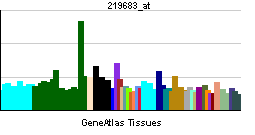FZD3
| Frizzled homolog 3 (Drosophila) | |||||||||||
|---|---|---|---|---|---|---|---|---|---|---|---|
| Identifiers | |||||||||||
| Symbols | FZD3 ; Fz-3; hFz3 | ||||||||||
| External IDs | Template:OMIM5 Template:MGI HomoloGene: 23004 | ||||||||||
| |||||||||||
| RNA expression pattern | |||||||||||
 | |||||||||||
| More reference expression data | |||||||||||
| Orthologs | |||||||||||
| Template:GNF Ortholog box | |||||||||||
| Species | Human | Mouse | |||||||||
| Entrez | n/a | n/a | |||||||||
| Ensembl | n/a | n/a | |||||||||
| UniProt | n/a | n/a | |||||||||
| RefSeq (mRNA) | n/a | n/a | |||||||||
| RefSeq (protein) | n/a | n/a | |||||||||
| Location (UCSC) | n/a | n/a | |||||||||
| PubMed search | n/a | n/a | |||||||||
Frizzled homolog 3 (Drosophila), also known as FZD3, is a human gene.[1]
This gene is a member of the frizzled gene family. Members of this family encode seven-transmembrane domain proteins that are receptors for the Wingless type MMTV integration site family of signaling proteins. Most frizzled receptors are coupled to the beta-catenin canonical signaling pathway. The function of this protein is unknown, although it may play a role in mammalian hair follicle development.[1]
See also
References
Further reading
- Katoh M (2002). "GIPC gene family (Review)". Int. J. Mol. Med. 9 (6): 585–9. PMID 12011974.
- Finch PW, He X, Kelley MJ; et al. (1997). "Purification and molecular cloning of a secreted, Frizzled-related antagonist of Wnt action". Proc. Natl. Acad. Sci. U.S.A. 94 (13): 6770–5. PMID 9192640.
- Wright M, Aikawa M, Szeto W, Papkoff J (1999). "Identification of a Wnt-responsive signal transduction pathway in primary endothelial cells". Biochem. Biophys. Res. Commun. 263 (2): 384–8. doi:10.1006/bbrc.1999.1344. PMID 10491302.
- Kirikoshi H, Koike J, Sagara N; et al. (2000). "Molecular cloning and genomic structure of human frizzled-3 at chromosome 8p21". Biochem. Biophys. Res. Commun. 271 (1): 8–14. doi:10.1006/bbrc.2000.2578. PMID 10777673.
- Sala CF, Formenti E, Terstappen GC, Caricasole A (2000). "Identification, gene structure, and expression of human frizzled-3 (FZD3)". Biochem. Biophys. Res. Commun. 273 (1): 27–34. doi:10.1006/bbrc.2000.2882. PMID 10873558.
- Hung BS, Wang XQ, Cam GR, Rothnagel JA (2001). "Characterization of mouse Frizzled-3 expression in hair follicle development and identification of the human homolog in keratinocytes". J. Invest. Dermatol. 116 (6): 940–6. doi:10.1046/j.1523-1747.2001.01336.x. PMID 11407985.
- Strausberg RL, Feingold EA, Grouse LH; et al. (2003). "Generation and initial analysis of more than 15,000 full-length human and mouse cDNA sequences". Proc. Natl. Acad. Sci. U.S.A. 99 (26): 16899–903. doi:10.1073/pnas.242603899. PMID 12477932.
- Katsu T, Ujike H, Nakano T; et al. (2004). "The human frizzled-3 (FZD3) gene on chromosome 8p21, a receptor gene for Wnt ligands, is associated with the susceptibility to schizophrenia". Neurosci. Lett. 353 (1): 53–6. PMID 14642436.
- Zhang Y, Yu X, Yuan Y; et al. (2005). "Positive association of the human frizzled 3 (FZD3) gene haplotype with schizophrenia in Chinese Han population". Am. J. Med. Genet. B Neuropsychiatr. Genet. 129 (1): 16–9. doi:10.1002/ajmg.b.30076. PMID 15274031.
- Zhang Z, Henzel WJ (2005). "Signal peptide prediction based on analysis of experimentally verified cleavage sites". Protein Sci. 13 (10): 2819–24. doi:10.1110/ps.04682504. PMID 15340161.
- Omoto S, Hayashi T, Kitahara K; et al. (2004). "Autosomal dominant familial exudative vitreoretinopathy in two Japanese families with FZD4 mutations (H69Y and C181R)". Ophthalmic Genet. 25 (2): 81–90. doi:10.1080/13816810490514270. PMID 15370539.
- Hashimoto R, Suzuki T, Iwata N; et al. (2005). "Association study of the frizzled-3 (FZD3) gene with schizophrenia and mood disorders". Journal of neural transmission (Vienna, Austria : 1996). 112 (2): 303–7. doi:10.1007/s00702-004-0264-2. PMID 15657645.
| Stub icon | This membrane protein–related article is a stub. You can help Wikipedia by expanding it. |
This article incorporates text from the United States National Library of Medicine, which is in the public domain.